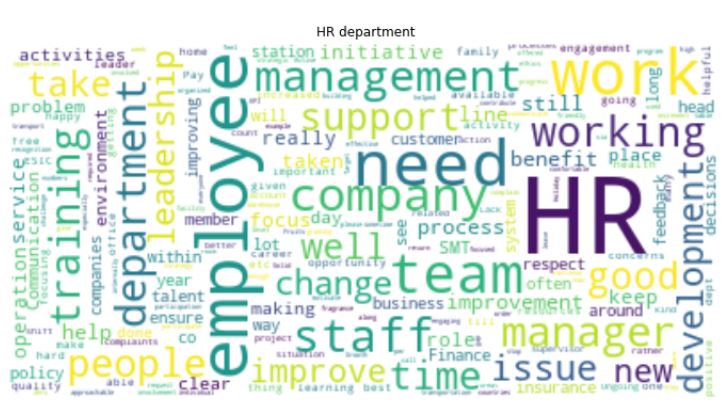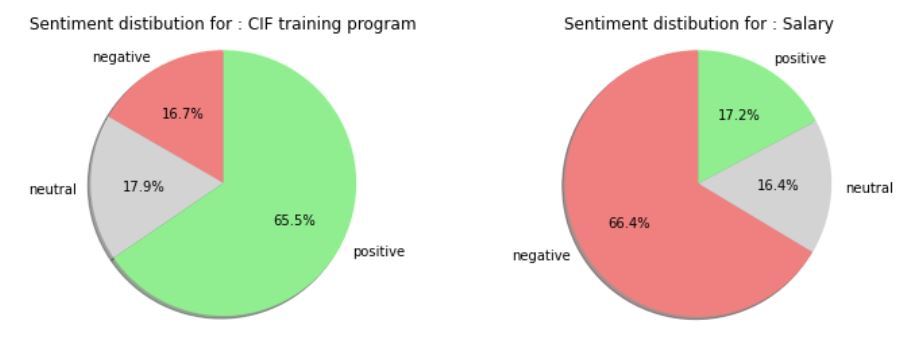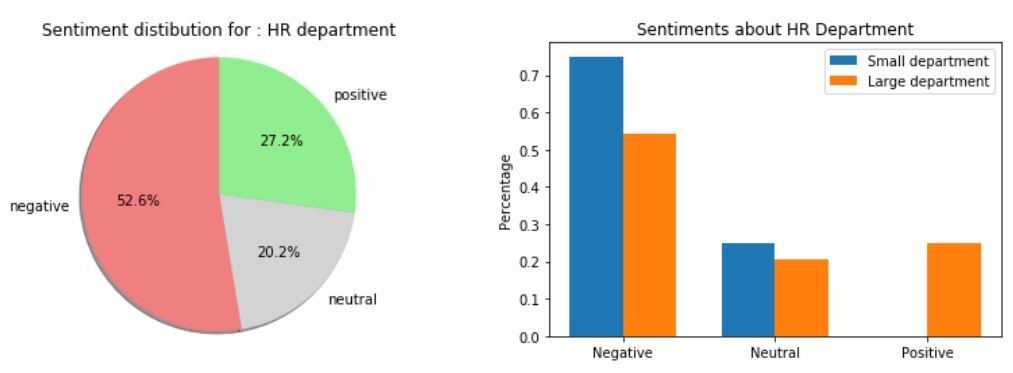Overview Data Preparation Topic Modeling Sentiment Analysis Outcome and Reflection
Outcome and Reflection
Outcome
When we apply our Natural Language Processing (NLP) pipeline consisting of Data Preparation, Topic Modeling, and Sentiment Analysis, using the employee survey comments provided by deepsight GmbH, we are able to report on this data from multiple perspectives. Since the end user is usually a Human Resource (HR) department, we chose to adopt an organizational psychology point of view and assemble our results to answer those questions which an HR department might wish to answer with such a survey. We below present the output of our NLP pipeline on the survey data with regard to relevant topics mentioned, sentiments towards these topics, and overall employee engagement.
Topic Modeling Results
From our document clustering approach we have extrapolated twelve relevant topics from the data:- Team Spirit
- Employee-Management Interaction
- Employee Opinion Survey (EOS)
- 'Non Answers'
- CIF Training Program
- HR Department
- Salary
- Operating Procedures
- Teamwork and Communication
- Customer Relations
- Cooperation
- Changes in the Company
The topic 'Non Answers' contains short, meaningless comments such as "no comment" or " - ". The topic 'Employee Opinion Survey' contains comments which primarily discuss the results and consequences of the previous employee opinion survey, which proved interesting to our analysis as it revealed the employees' collective conception of these surveys. We inspected each topic with respect to average comment length, which we adopt as an indicator of employee engagment. Our assumption is that if a comment is longer, the employee providing the comment is more engaged.

Figure 1: Employee engagement as a function of average comment length for each identified topic.
As demonstrated in Figure 1, the topic with the longest comments in 'Salary', with an average of 168 characters per comment. This value seems intuitive, since salary is generally a controversial topic which affects every employee. Other topics which contained long comments include 'Employee-Management Interaction' (163 characters) and 'HR Department' (152 characters). The topic with the shortest comments is the aforementioned 'Non Answers' topic, with an average comment character-length of 21.
The language content of each topic can be visualized with 'word clouds' which show the most frequent words mentioned in the comments of each topic. The size of the word is positively-correlated with the frequency of the word in the topic. Colors have no meaning, but help to visually-distinguish the words. In sum, the word cloud visualization can be helpful to gain a superficial overview of 'what a topic is about.' For example, in Figure 2, the word cloud for the topic 'HR Department,' words such as "HR" and "department" are prominent along with related words such as "employee," "support," "training," "management," "team," and "staff."

Figure 2: Word cloud for a topic about HR department.
To gain further qualitative insights into each topic, we also extracted representative comments. For example, for the topic
'CIF Traning Program' the representative comments include:
- “I feel that the CIF program and its different modules are a big investment and that its results will be favorable to [company]. I believe that this types of programs are much needed to change the culture and achieve the results [company] needs.
- “CIF training was an eye opener. If we felt that we were working for a good company, the perception changed to we are working for the worlds greatest company. The fact that we can leverage on the network for support and speed is awesome.”
The comments clearly suggest a positive sentiment. From this additional qualitative analysis, on can then verify sentiment quantitatively via sentiment analysis.
Sentiment Analysis Results
While the sentiment of the comments is strongly-correlated with the prompting question, there are considerable differences in the sentiment distributions among the different topics. Such variations can be employed to determine what aspects of the company are currently satisfactory to employees, and which demand improvement. As seen in Figure 3, the most positive topic is the 'CIF Traing Program,' with 66.5% of the comments having a positive sentiment. The most negative topic, 'Salary,' reveals only 17.2% of the comments to have a positive sentiment.

Figure 3: Sentiment distribution for most-positive and most-negative topics.
In addition to the qualitative, content-related information provided by the outputs of the topic modeling pipeline, our sentiment analysis provides valuable insights into the feelings of employees towards specific processes and departments of the surveying company. This sentiment can again act as an indicator of employee engagement level.
Additionally, when cross-analyzing sentiment with additional question metadata such as surveyed department, we are able to produce a finer-grained analysis indicating the distribution of topic sentiment across the different departments. As seen in Figure 4, when splitting the sentiment analysis of the topic 'HR Department' across the two surveyed departments, there exists a clear divide in opinion across the two groups of employees.

Figure 4: Sentiment distribution for 'small' and 'large' departments for a sample topic.
Although for both departments the sentiment towards the HR Department is primarily negative, when splitting across the two departments it is revealed that the large department has generally more positive sentiment towards the HR Department than the small department. This information can provide helpful indicators towards precise interventions, e.g. that interventions directed towards HR Department activity in the small department be prioritized or further-investigated in conjunction with representative comments from the topic.
Conclusion
Because our project's main focus was on the technical implementation of the NLP pipeline, the above analysis represents only a fraction of the possibilities for statistical analyses which may shed light on the topics and opinions contained in the investigated dataset. Nonetheless, these results should give an impresssion of the utility of our methods, as without these computational means arriving at similar insights would likely prove very time-consuming. In short, our analysis pipeline proves superficially-effective in delivering actionable insights quickly and objectively. However, it must be kept in mind that our approaches remain prone to error and subject to improvement.
Reflection
The combination of Machine Learning and NLP is an exciting new field of research and our cooperation with deepsight GmbH proved an excellent opportunity to apply theoretical knowledge towards resolution of a real-world use-case. In addition to learning and exploring state-of-the-art technologies we also developed soft-skills such as project management, teamwork, and interdisciplinary communication.Since university study projects rely on student self-organization, the quality of the project and its outcome depends on the commitment of the individual participants. In this regard, our study project was a good experience due to the significant intrinsic motivation within the team. Finally, we would like to thank Dr. Alexander Meier from deepsight GmbH and Prof. Dr. Michael Franke from the University of Osnabrück for providing valuable ideas and input, and for supporting the project from the beginning.